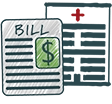Menu

CALL FOR A FREE CONSULTATION
Exceptional Legal Representation Throughout
Long Island and New York, Since 1993.

CALL FOR A FREE CONSULTATION
Exceptional Legal Representation Throughout
Long Island and New York, Since 1993.









Debt Negotiation and Settlement Attorneys – Nassau and suffolk to Brooklyn and Queens
Our law firm specializes in strategic and assertive debt settlement negotiations, frequently securing favorable outcomes for our clients. These settlements are often mutually beneficial, as creditors may prefer resolution over the risks associated with bankruptcy or litigation.

Debt Negotiation and Settlement Attorneys – Suffolk & Nassau Counties, Brooklyn
Clients frequently seek the Law Office of Ronald D. Weiss, P.C. for skilled representation in negotiations with banks, mortgage lenders, credit card companies, auto financing providers, landlords, tax authorities, and other creditors. Our firm enhances our clients’ ability to secure favorable settlements through:
Our Negotiation Process
We guide clients on realistic settlement expectations and the offers creditors are likely to accept. Throughout the process, we provide updates on case progress, creditor communications, and ongoing settlement efforts. Once an agreement is reached, we formalize it with the creditor and ensure all necessary legal documentation is in place.
Types of Debts We Negotiate and Settle
Bankruptcy vs. Debt Settlement
While bankruptcy offers a comprehensive solution for debt relief, it is not always the best option. Some clients may:
Our Approach to Debt Negotiations
We tailor settlements to each client’s situation, offering:
Through a well-planned and strategic approach, we help clients achieve lasting debt relief solutions that protect their financial well-being.

Many of our clients have multiple personal debts that require skilled negotiation. To streamline the process, we establish individual files for each creditor, containing essential details such as payment history, negotiation records, contact information, and loan specifics. We systematically reach out to creditors via written communication and phone calls to secure favorable settlements. This structured approach ensures effective progress tracking and keeps our clients well-informed.
Our deep expertise in bankruptcy law and litigation defense strengthens our negotiation position. Creditors recognize that if a fair settlement cannot be reached, our clients may pursue legal alternatives such as bankruptcy or litigation.
Our Debt Negotiation Process
1. Client Information and Documentation
We begin with an intake meeting where our paralegals collect relevant documentation and assess the client’s financial history, debts, and prior negotiations. Understanding their income, expenses, budget, and financial constraints helps us determine the most viable settlement options. The client’s ability to contribute to a settlement—whether through lump-sum payments, installments, or a combination—plays a key role in structuring negotiations.
2. Comprehensive Financial Analysis
To gain a complete picture of the client’s financial standing, we conduct thorough asset, debt, and legal searches, including:
3. Contacting the Creditor
A key step in debt negotiation is identifying the appropriate creditor representative. Since debts may be assigned or sold to collection agencies, servicers, or legal representatives, we ensure that we are negotiating with the correct party authorized to settle the debt.
Once identified, we send a formal letter outlining:
This approach encourages creditors to engage in meaningful negotiations.
4. Negotiation and Offer Strategy
Debt negotiations typically involve multiple rounds of offers and counteroffers. Our approach includes:
If an initial offer is declined, re-engaging later can sometimes lead to a better settlement outcome.
5. Finalizing the Settlement Agreement
Once a settlement is reached, we ensure that a formal agreement is executed to protect our client’s rights. Clients must comply with the settlement terms to fully resolve their debts.
Upon completion, we secure the necessary legal documentation, such as:
Through our strategic and structured approach, we help clients achieve lasting debt relief while safeguarding their financial future.

At our law firm, we utilize our expertise in bankruptcy and litigation as powerful negotiation tools. When engaging with creditors, we make it clear that if a fair settlement cannot be reached, our clients may pursue bankruptcy or litigation—not as a mere threat, but as a viable legal alternative. The potential consequences for all parties involved often encourage creditors to engage in meaningful negotiations.
1. Bankruptcy as a Negotiation Strategy
Creditors are more inclined to accept a negotiated settlement when they recognize that a client may file for Chapter 7 bankruptcy. Under Chapter 7, most or all unsecured debt can be discharged without repayment, and the case is typically resolved within three and a half months—assuming no complex legal issues arise.
For clients who do not qualify for Chapter 7 due to high income or significant unprotected assets, Chapter 13 bankruptcy offers an alternative. Chapter 13 reorganizes debt into a structured 60-month repayment plan, often without additional interest on the majority of the debt. This structured approach allows clients to make manageable monthly payments while avoiding severe financial consequences.
Because our firm routinely handles bankruptcy cases, creditors understand that the risk of bankruptcy is real. This often prompts them to negotiate rather than face the possibility of losing the entire debt in a bankruptcy discharge. If creditors remain uncooperative, filing for bankruptcy remains a viable solution to restructure or eliminate the debt.
2. Litigation as a Negotiation Strategy
The potential for litigation defense can also make a negotiated settlement more appealing to creditors. Litigation allows clients to:
✔ Dispute alleged credit card debt
✔ Challenge improper collection practices
✔ Assert their legal rights through the judicial system
Many creditors assume that debtors will not challenge their claims, often leading them to take aggressive collection actions. However, our firm specializes in litigation defense, creating potential legal hurdles that can increase costs and cause prolonged delays for creditors. As a result, creditors often prefer to settle rather than risk costly and uncertain litigation.
Common Legal Disputes in Debt Litigation
Lack of proper notice or collection attempts
Insufficient proof of nonpayment or late payments
Unreasonable loan terms or misleading agreements
Excessive fees, penalties, or interest charges
Missing or unenforceable contracts
When creditors initiate legal action, we assist our clients by:
Filing timely responses to summons and complaints (within 20–30 days)
Submitting motions to dismiss or contesting summary judgment requests
Issuing discovery demands to scrutinize the debt’s legitimacy and uncover potential defenses
Since creditors are generally unprepared for prolonged legal battles, they often choose to settle rather than engage in expensive and time-consuming litigation.
Through our strategic use of bankruptcy and litigation, we maximize our clients’ chances of securing favorable debt settlements while protecting their financial future.
While bankruptcy provides debt relief, certain financial circumstances may make it infeasible or less advantageous for some clients. In these cases, debt negotiation can serve as a more practical alternative.
1. Excess Income Preventing Chapter 7 Bankruptcy
Eligibility for Chapter 7 bankruptcy is determined by the means test, which compares a client’s income to the New York State median. If a client’s income exceeds this threshold by $10,000 to $15,000, they may not qualify for Chapter 7.
Before filing, a thorough income assessment is essential, considering household size and necessary living expenses.
For those ineligible for Chapter 7, Chapter 13 offers an alternative with different income limits. However, if neither Chapter 7 nor Chapter 13 is viable due to excess income, debt negotiation becomes a practical solution.
2. Excess Equity in Unprotected Assets
Clients with significant unprotected equity may face liquidation risks under Chapter 7. The bankruptcy trustee can sell non-exempt assets to pay creditors—unless those assets are protected by secured loan liens or state/federal exemptions.
New York allows filers to choose between state and federal exemption structures, including:
Homestead Exemption – Protects up to $170,825 per homeowner in New York
Federal Wildcard Exemption – Covers personal property (e.g., vehicles, bank accounts) up to $13,400
If a client’s unprotected assets exceed exemption limits, Chapter 7 may not be ideal. Similarly, if Chapter 13 repayment plans prove too costly, negotiation may be the safest debt resolution strategy.
3. Issues with Avoidable Transfers
Certain financial transactions before filing for bankruptcy can complicate the process. These avoidable transfers include:
Preferences – Payments made to certain creditors within 90 days before filing
Insider Transfers – Payments to relatives or close associates within one year before filing
Fraudulent Transfers – Transferring assets to family or friends for less than fair value within six years before bankruptcy
These transactions may trigger legal challenges in Chapter 7 or make Chapter 13 too expensive. In such cases, debt negotiation can be a better alternative.
4. Low Debt Relative to Creditors
For clients with minimal debt or few creditors, bankruptcy may be unnecessary. While Chapter 7 eliminates debt, settlements or partial payments may be less damaging to a credit report.
A negotiated settlement labeled “Settled Outside of Terms” may have a smaller impact on credit than a Chapter 7 discharge.
However, successful negotiations require clients to meet payment obligations consistently. If a client struggles with settlement payments, bankruptcy may still be the more effective option.
5. Risk of Bankruptcy Objections
Bankruptcy discharges may face creditor objections in cases of:
Abusive Debt Accumulation – Large cash advances or balance transfers shortly before filing
Potential Litigation – Creditors challenging dischargeability through adversary proceedings
To mitigate these risks, Chapter 13 or 11 repayment plans may provide a structured solution. However, if a client has the financial means, negotiating settlements may be preferable to facing a contested bankruptcy discharge.
Through careful analysis of each client’s financial situation, we help determine the best path forward, ensuring effective debt relief without unnecessary risks.

In some circumstances, bankruptcy may prove more advantageous than debt negotiation, especially when a client lacks the financial resources or ability to negotiate effectively. These situations include:
1. Inability to Negotiate a Settlement
Negotiating a debt settlement often involves offering creditors a lump sum or installment payments. If a client lacks the financial means to settle their debts, bankruptcy may be a better alternative for debt relief.
2. Preference for Bankruptcy’s Quick Debt Elimination
Even if a client has the ability to negotiate their debt, Chapter 7 bankruptcy often provides a more efficient solution. A Chapter 7 discharge typically occurs within a few months, and most cases are categorized as “no asset” cases, meaning the client does not pay creditors or trustees. Compared to the lengthy process of settlement negotiations, Chapter 7 is faster, more cost-effective, and simpler.
3. Tax Consequences of Debt Settlement
Outside of bankruptcy, forgiven debt may be treated as taxable income, potentially leading to a significant tax burden. In contrast, debt discharged through bankruptcy is not taxable. While some exceptions to debt cancellation taxes exist—such as in cases of insolvency at the time of forgiveness or debt treated as a gift—bankruptcy eliminates these concerns entirely.
4. Fragmented, Hard-to-Reach, or Difficult-to-Settle Debts
When debts are spread across multiple creditors, are difficult to track, or are hard to negotiate, bankruptcy can provide a more streamlined solution. Chapter 7 discharges all eligible debts, even those the client may not be aware of, making it a more effective option when negotiation proves impractical.
By considering each client’s specific circumstances, we can help determine whether bankruptcy or negotiation offers the most appropriate debt relief strategy.

Debt negotiation is often the better approach when there are fewer disputes and the debt amount is relatively small, such as in credit card cases. However, litigation may become necessary if the debts are larger, unique, or highly contested. In most cases, particularly with credit card debt, litigation is a risky strategy, usually employed to buy time or gain leverage. Negotiation is generally the more favorable option in the following situations:
1. Undisputed Debt Without Strong Litigation Defense
When a debt is undisputed and there is little legal ground for contesting it, negotiation should take precedence—unless the debt was incurred in violation of procedural laws. If a client understands the risks, costs, and limitations of litigation, it may be considered, but for straightforward cases, negotiating a settlement is typically the best approach, especially if bankruptcy is not a viable or preferred solution.
2. Litigation Is Expensive, Lengthy, and Complex
Litigation can be an expensive, time-consuming, and complex process. Even if there is a legal case, litigation is often avoided when a client has multiple debts, numerous creditors, or financial constraints. Litigation is usually more effective in situations involving a single, highly contested debt. Due to the high costs, time commitment, and complexity, it should only be pursued when the benefits clearly outweigh the drawbacks.
3. Using Litigation as Leverage in Negotiations
Even if litigation or bankruptcy is not the ideal course of action, having these options available can provide valuable leverage during negotiations. By informing creditors of potential legal remedies, they may be more inclined to reach a reasonable settlement.

When a client is unable or unwilling to file for bankruptcy, our office works directly with creditors to negotiate lump sum settlements or structured payment plans. Given our experience handling bankruptcy cases, creditors are aware that, while we explore bankruptcy options, we prioritize negotiated resolutions. As a result, we often secure settlements that reduce debt to 33–50% of the original amount. In cases where a payment plan is required, we work to reduce the loan amount in terms of interest and monthly payments.
1. Approach: Highlighting Bankruptcy or Litigation as Alternatives
In every negotiation, we emphasize to creditors the benefits of an offer. As specialists in bankruptcy and litigation defense, we inform creditors of these more drastic options and their potential risks. Our primary objective is to encourage creditors to agree to a fair settlement rather than face the possibility of bankruptcy or litigation.
2. Key Hardships to Emphasize During Negotiations
We present the financial hardships our clients have experienced, including:
Additionally, we emphasize the client’s low income and minimal asset equity. This helps position the settlement as the creditor’s best chance to recover a portion of the debt.
3. Structuring a Settlement Agreement
We present multiple settlement options, considering factors such as:
Our agreements usually involve a reduced principal balance, no future interest or late fees, and no large final balloon payment. The main negotiation points are the amount of principal paid and the repayment duration.
4. Finalizing the Debt Settlement Agreement
Once a settlement is reached, we formalize the agreement with the following documents:
Our office ensures all necessary documentation is in place to protect our clients and confirm that the negotiated terms are properly executed.

Most marketing campaigns targeting individuals seeking debt relief promote companies specializing in debt consolidation or reduction, which operate differently from our legal practice. Below, we explain the crucial distinction between these methods and our debt negotiation and settlement strategy.
Debt Consolidation
Debt consolidation is a widely promoted debt negotiation strategy, but it is a limited solution. It generally does not aim to reduce the principal debt but focuses on lowering the client’s interest payments. These companies employ large administrative teams that primarily negotiate lower interest rates with credit card issuers. They consolidate all monthly payments into one, add their service fee, and create a long-term repayment plan that often spans five years or more.
However, there are several drawbacks to this approach. Many clients facing financial difficulties do not receive substantial debt reduction. Payment plans often fail due to miscommunications, delays, or misallocated payments—whether by the client, the debt consolidation company, or both. As a result, this strategy typically addresses only a portion of the client’s debt. Moreover, at the end of the payment period, the credit report may reflect “settled not according to terms,” which may ultimately be a negative mark. Many clients realize, after several years, that debt consolidation does not provide an adequate solution.
Debt Reduction
Another commonly advertised strategy is debt reduction, which comes with even more limitations and challenges. This approach is marketed as a way to reduce the total principal owed, often implying it can fully resolve a client’s debt. However, debt reduction companies also operate with large administrative teams and frequently use misleading marketing tactics.
These companies require clients to make payments over several months to build a lump sum. Once enough funds are accumulated, they attempt to negotiate a reduced settlement with one creditor at a time. After resolving one debt, they move on to the next, collecting payments until they have enough for the next settlement. While one or two debts may be settled, other creditors are often ignored and may send unpaid accounts to collections or file lawsuits. Many clients realize after a year or so that debt reduction services fail to address their total debt situation effectively.
Our Approach to Debt Negotiations and Settlements
In contrast to debt consolidation, our strategy focuses on reducing individual debts by:
Unlike debt reduction companies, we don’t negotiate with just one creditor at a time. We engage with all creditors from the start, preventing ignored creditors from pursuing lawsuits and allowing us to explore settlement options across the board. If a lump-sum settlement is not feasible, we can negotiate an installment plan or a hybrid agreement. Our method combines the best aspects of both debt reduction and consolidation without their inherent drawbacks.
Our Experienced Negotiation Team Finds Tailored Solutions for Every Debt
Unlike debt consolidation and reduction companies that rely on large administrative teams, our Negotiations Department consists of highly skilled professionals with legal or advanced educational backgrounds. These mass-market companies use standardized, generic approaches to debt settlement, prioritizing efficiency and automation over client interests. This often leads to a one-size-fits-all approach that may not be ideal for every situation.
In contrast, our team evaluates each case individually to ensure the best possible outcome. When negotiations become complex, our skilled negotiators explore alternative strategies to secure comprehensive debt relief tailored to our clients’ needs.
When exploring debt relief options, it’s essential to carefully consider a) Negotiated Settlements, b) Bankruptcy, and/or c) Litigation Defense. Our experienced and affordable legal team is here to help you protect your home and navigate the best path forward.
While our legal guidance is invaluable, our consultations come at no cost to you.
For a free legal consultation at our Brooklyn law office to discuss your debt settlement options in detail, please call us at (631) 250-4120 or email us at weiss@ny-bankruptcy.com.
MONDAY – FRIDAY -8.30 AM – 8.30 PM